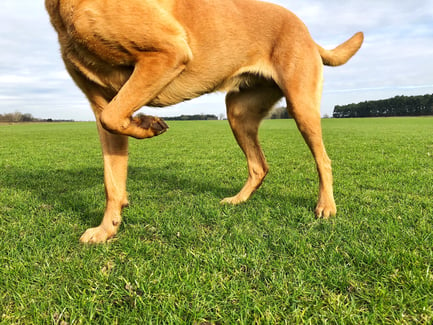Table of Contents
Your dog is running around playing like they normally do when suddenly they stop and yelp and start hopping around, holding their paw up in pain.
Sometimes dogs don’t even have to be playing or running around to sustain a dog paw injury, it can happen as they are walking around at home or on a walk around the neighborhood. Just like a person can accidentally step on something sharp and get an injury to their foot, a dog’s paw pads are just as susceptible.
If you take a close look at your dog’s paw, you’ll see several pads:
|
Type of Paw Pad |
Location |
|
Digital pad |
|
|
Metacarpal/Metatarsal pad |
|
|
Carpal/Tarsal pad |
|
|
Dewclaw pad |
|
Each of your dog’s paw pads provides traction, protection from temperature (to a point), and shock absorption as they walk and run.
Although your pup’s paw pads offer some protection to the feet, a dog paw injury can still happen in an instant and can range from mild to severe. Sometimes it isn’t obvious that a dog even has a paw pad injury until you recognize that they are showing certain symptoms that indicate they are uncomfortable.
A dog pad injury can sometimes heal on its own without any intervention needed, while other times, you need to simply clean the area and cover it to help it heal. With a more severe dog paw pad injury, you may even need to take your pup to the vet for some antibiotics.
In any case, it’s important to be able to recognize the signs and symptoms that your dog may be suffering from an injury to their paw pad so that you can take the appropriate action. After all, getting your pup back to their normal happy, and goofy selves is the goal!
In this article, we explore the causes, symptoms, and treatment options for a dog paw pad injury so that you know what to look for, can perform basic treatment on your own, and know when it’s time to take your pup to the vet.
Causes of Dog Pad Injury
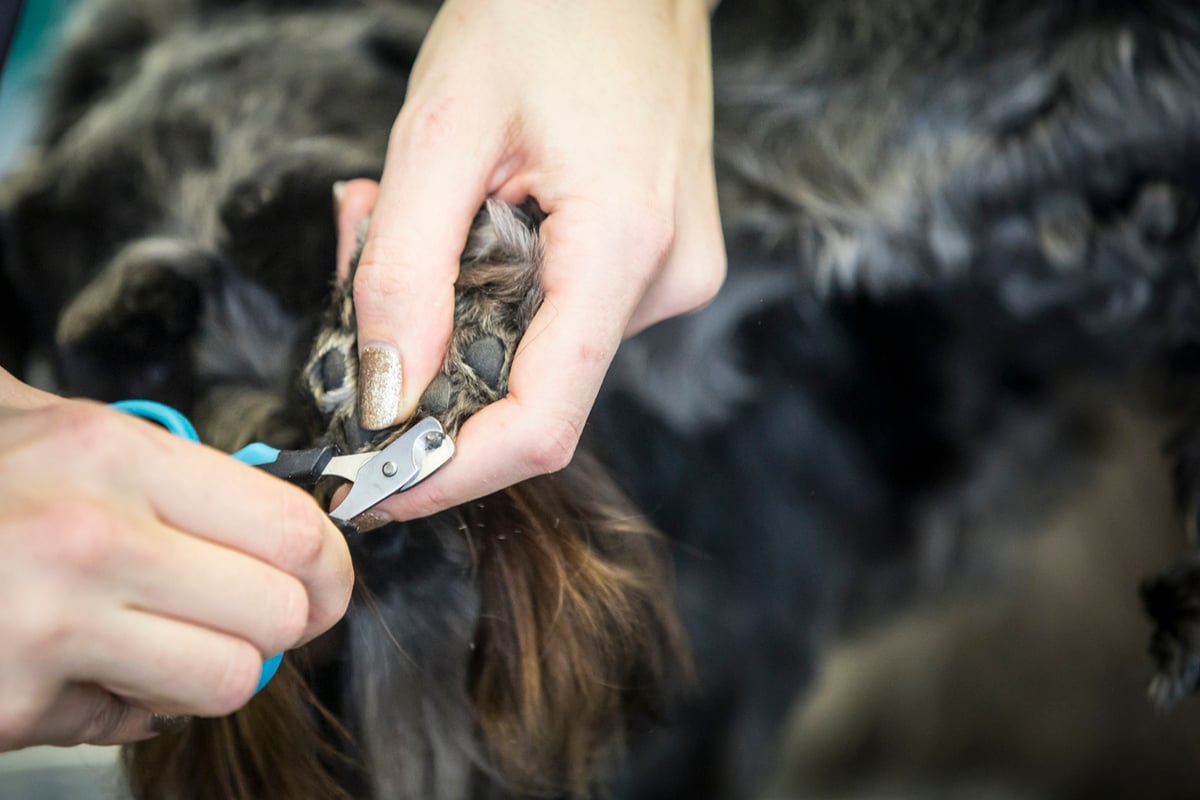
There are many potential causes of a dog foot pad injury. A simple walk through the yard or the kitchen can result in a paw pad injury due to a misstep or slip, while more intense activities like hiking in the woods can result in no paw pad injury.
Being aware of the potential causes of a dog paw pad injury doesn’t mean you should wrap your pup in bubble wrap, but gives you more insight into what can happen and how you can help your dog in each specific situation.
1. Cuts, Abrasions, and Scrapes
Likely the most common dog paw pad injury you’ll experience with your pup will be a cut, abrasion, or scrape that usually results in bleeding. These types of injuries can be caused by pretty much anything, from stepping on a sharp object to trying to catch a ball or toy and scraping the paws on hard ground.
Minor cuts, abrasions, or scrapes will usually heal on their own, but it’s never a bad idea to keep your dog’s paw clean while the dog paw pad injury heals and have your dog wear booties during your next walk to protect the injury. For more severe injuries, you may need to take your dog to the vet so they can assess whether your pup needs stitches, antibiotics, or any other additional care.
2. Thick and Hard Calluses
Typically, the outer layer on your dog’s paw pads will become callused over time, especially if they spend a lot of time outside walking on harder surfaces like cement or packed dirt. However, some dogs may have softer paw pads because they spend the majority of their time inside or walking on softer surfaces like grass.
Like people, calluses protect a dog’s paw pads to a point, but calluses that are too thick and hard are more susceptible to cracking and bleeding, leading to infection. Doggy-approved foot balms help keep your pup’s paw pads nice and pliable.
3. Nail Catching
Another common injury that can affect your dog’s paw pad is nail catching. Dogs getting excited during fetch and running at full speed only to stop on a dime to catch a toy, inadvertently catching their nail in the carpet or grass is one way that nail catching injuries can occur. The nail goes deep into your dog’s foot, so if the injury is severe enough, it can absolutely affect your dog’s paw pad.
A nail catching injury can be pretty painful for your pup as there are a lot of nerve endings in the tips of their toes, and there can be a lot of blood. Other than the distress that the injury can cause, it’s very treatable. Usually, a veterinarian will check for a broken digit, then clean and wrap up the area with some topical antibiotic ointment. Your pup may even need a cone to keep them from licking and biting the area while it heals.
4. Burns or Frostbite
While it’s important to ensure that your dog gets enough exercise, taking them for a walk on hot concrete at the hottest time on a summer’s day can potentially burn their paw pads. On the other hand, walking your dog on super cold surfaces during the winter can result in frostbite.
In addition, many cities and towns, especially in northern climates, use road salt that contains chemicals that help melt ice. This is done in an effort to make the roads and sidewalks safer for people to walk on, but unfortunately, the chemicals in the road salt can burn your dog’s feet. Pieces of salt can get stuck in between toes and in fur, increasing the risk of burns to your dog’s skin.
Walking your dog when it’s cooler outside during the summer, or sticking to grassy areas is a great way to prevent burns. During winter, getting your dog to wear booties, or thoroughly washing their feet and paws when they come inside from a walk helps prevent chemical burns from road salt.
5. Sharp Objects
Dog paws may be tough, but if they step on a sharp object, it can go through the skin just as easily as when we step on something sharp. Sticks, tree bark, screws and nails, and porcupine quills are just a few examples of things that your dog could step on. Making sure the area where your dog is playing is free from any sharp objects is key, so cleaning up your yard after you finish building your deck or shed is one way that you can prevent your dog from accidentally stepping on something they shouldn’t.
Porcupine quills might be another story, though. These spiky creatures seem to attract dogs like magnets, especially in rural areas, so supervising your dog when they are out is the best way to hopefully prevent them from getting too close.
6. Lameness
If you have a dog suffering from lameness due to a joint condition, their lack of coordination puts them at greater risk of experiencing a paw pad injury. Plus, it might be more difficult to tell that they have a dog paw pad injury because the signs that they are in pain may be mistaken for their joint condition.
One of the best things you can do for your dog to help prevent painful joints is to feed them a daily joint supplement containing glucosamine for dogs. Integricare’s TRI-ACTA is a great choice, as it not only contains 100% natural ingredients but also has two types of glucosamine: sulfate and HCl, which provide unique benefits for your dog’s joint health. Sulfur is an essential component of your dog’s joint structures, so providing it in glucosamine sulfate ensures that your dog is getting enough sulfur to aid in the regeneration and protection of joint tissues. Glucosamine HCl is a highly bioavailable form of glucosamine, meaning that your dog’s body will be able to use it faster to help support cartilage repair.
Other ingredients, like chondroitin (works with both types of glucosamine to aid in cartilage regeneration and repair) and Methylsulfonylmethane (MSM, a natural anti-inflammatory) provide maximum support for your dog’s joints as they age.
If your pup is already suffering from arthritis or other joint issues or is up there in age, then our extra-strength TRI-ACTA H.A. is available. It adds hyaluronic acid, which thickens the synovial fluid in your dog’s joints, reducing pain and allowing for easier movement.
TRI-ACTA H.A. for Pets
Our maximum strength formula is optimally designed to accelerate the formation of cartilage, minimize inflammation, expedite the healing process, and improve joint conditions.

Symptoms of Carpal Pad Injury Dog
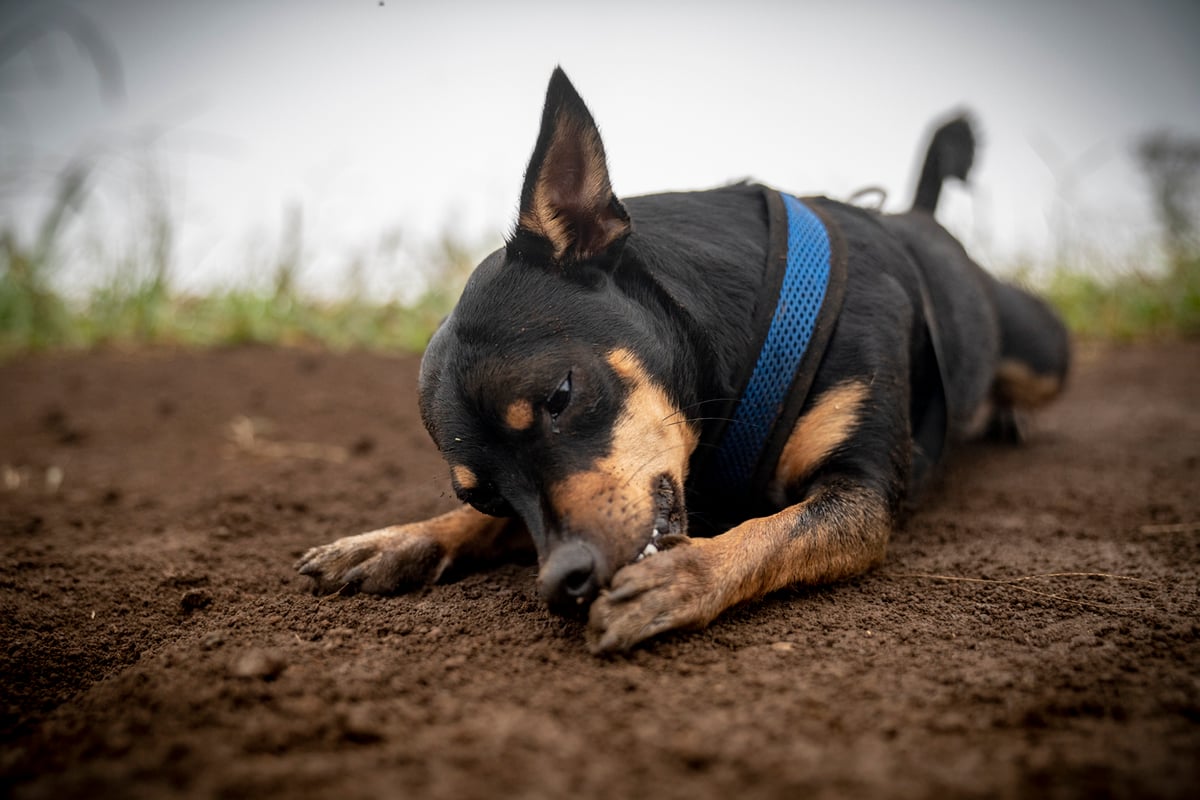
The carpal pad is just above the dew claw on your dog’s foot. This seemingly extra paw pad is to help your dog quickly stop when running or going down a steep hill or slope. If you’ve ever played fetch with your dog and saw them stop and pivot to catch a ball that bounced in an unexpected direction, they likely used their carpal pads to accomplish the feat.
Given the fact that the carpal pad is so instrumental in your dog’s acrobatics, it’s not difficult to imagine that this key movement area could get injured.
The symptoms of a carpal pad injury are the same as if another dog paw pad injury happened and include:
- Sudden canine lameness, which includes limping, painful reactions when your dog tries to set their paw down, and whining or whimpering
- Swelling at the site and hot to the touch
- Your dog wants to repeatedly lick or bite at the affected area
- Bleeding from the paw pad
- Discoloration of the paw pad, including redness
- Yellow, white, or green discharge from the paw pad (usually indicates an infection)
- Behavioral changes, such as being more irritable and aggressive than normal
- Lethargy and overall disinterest in activities that usually excite your pup (such as walks)
It’s important to know that signs and symptoms are actually different:
- Signs are objective findings that can be seen or measured (e.g., bleeding, discoloration, swelling)
- Symptoms are subjective in that they are perceived by the being that’s experiencing them (e.g., pain)
Sometimes determining symptoms can be tricky with animals since we can’t directly ask them if they are experiencing pain or discomfort. With animals, we must look for physical signs of certain symptoms. For example, it’s easy to figure out that a dog foot pad injury that’s bleeding is probably painful.
The behavioral signs that a dog is experiencing pain can be trickier, but if you know your dog well, they are easier to spot. If your dog is normally very happy-go-lucky, for example, and suddenly they are snapping and wanting to stay away from you, that’s a clear sign that something is wrong, and they’re likely in pain. Connecting the dots with signs and symptoms is key for knowing when they might be experiencing an injury that isn’t so obvious.
Dog Paw Injury Treatment
A dog paw pad injury can happen at any time. Depending on the nature of your pup's dog paw pad injury, there are different approaches to treatment. You might be on a walk or at home, but even if you don’t have many resources available immediately, there are still some important things you can do.
You might even want to add some things to take with you on a walk (alongside poop bags, of course!) to make treating an unexpected injury to a dog paw pad easier, such as:
- A water bottle
- Clean towel
- Tweezers
- Flexible bandage
What to Do for Dog Paw Pad Injury
If you notice that your pup has a dog foot pad injury and have what you need to treat it on the spot, here are some essential dog first aid steps that you can use to help your pup feel more comfortable:
- Gently clean the area of dirt and debris with clean water.
- If the area is bleeding and free of debris, apply pressure to the paw to help stop the bleeding. If the paw doesn’t stop bleeding in a few minutes or the wound is clearly too deep for pressure to help completely stop the bleeding, you’ll want to bring your pup to the vet immediately.
- Use tweezers to gently remove surface debris that is hard to grab with your fingers. If a sharp object is stuck far into your dog’s paw, DO NOT remove it because the bleeding will worsen. Instead, bring them to the vet for removal.
- If you’re home and can access a basin or bowl, soak your dog’s paw in cool water to help loosen any stuck debris naturally.
- Use a gentle antibacterial soap like Dawn dish soap or baby shampoo to help clean the dog paw pad injury and provide some relief to your pup, but avoid harsh chemicals like hydrogen peroxide or rubbing alcohol.
- Use a dry, clean cloth or towel to pat the area dry gently. Avoid rubbing, as this may irritate the wound further.
- apply coconut oil to your dog’s paw if you have some on hand. Small amounts of human antibacterial ointment (like Neosporin) are okay, but if your dog ingests too much, it can irritate their stomach.
- Wrap the paw up using a flexible bandage and gauze, and consider using a cone (Elizabethan collar) for your dog if they continuously want to lick and bite at the area.
After the dog pad injury treatment, keep a close eye on it for a few days, changing the bandage at least once daily. If the dog paw pad injury appears to be getting better, continue regular cleanings and dressings until it heals. However, if swelling doesn’t go down or bleeding or discharge occurs, bring your dog to the vet immediately. There could be a hidden break in your dog’s paw or a stuck foreign object causing additional issues that need to be taken care of.
When to See a Vet About an Injury to Dog Paw Pad
Aside from the obvious scenario where your dog has a clearly severe injury to their paw pad, there are other cases where you’re better off taking your dog straight to the vet for treatment:
1. Excessive or Uncontrolled Bleeding
It’s not unusual for a dog paw pad injury to bleed, as there are a lot of blood vessels in your dog’s feet. However, if the injury to the dog paw pad doesn’t stop bleeding even after pressure is applied for a few minutes or the bleeding is excessive, it’s time to bring your dog to the vet. Excessive blood makes it difficult to see if there is a foreign object aggravating the bleeding or if the wound is deep, but a veterinarian has the knowledge and tools to conduct a thorough examination.
2. Burns
If your dog’s paw pad is burned in any way, it’s always a good idea to bring them to the vet for additional care. The different ways that dog burns are classified are outlined in the table below:
|
Burn Level |
Description |
|
Superficial burn (first-degree) |
Involves only the dermis (outermost layer of the skin), resulting in pain and redness. First-degree burns usually heal within a few days with basic care (cleaning and bandaging), with a minimal risk of infection. |
|
Partial-thickness burn (second-degree) |
Involves the dermis and epidermis (slightly deeper skin tissues) and causes redness, swelling, blistering, and drainage. These burns usually take a couple of weeks to heal and have a higher risk of infection. |
|
Full-thickness burn (third-degree) |
Involves the dermis, epidermis, and subcutaneous tissue (the deepest layer of skin and tissue). This burn is the most severe as it can result in loss of pain sensation due to damaged nerves. The affected tissue can appear red, white, or black. Debridement (removal of dead tissue) is often necessary to prevent infection and allow new tissue to grow. Surgical repair, including skin grafts, may be needed. Healing is prolonged, and the risk of infection is high. |
Damage to the deeper tissues in your dog’s paw might not be immediately obvious, as it takes time for the outermost layers of the skin to die. This makes it easy to underestimate the severity of a burn, especially when it's a chemical burn (often caused by chemicals like drain cleaners (lye), acids, gasoline, or paint thinner) or thermal burn (heat). Even the heat caused by the friction from a mechanical burn (caused by friction from a surface traveling over the skin, like carpet, asphalt, or rope) can result in additional damage to tissues over time.
3. Deeply Embedded Foreign Object
If your dog steps on something that deeply embeds into their paw pad, like a piece of glass, stick, or nail, it’s best to take them to a veterinarian for removal. Attempting to remove a deeply embedded object in your dog’s paw pad yourself will likely result in excessive bleeding and increased damage to the surrounding tissues and skin. On the other hand, a veterinarian has specialized knowledge and tools available to help prevent any damage and bleeding as much as possible. They can immediately administer antibiotics and pain medication to help make your dog more comfortable.
How to Prevent Dog Paw Injury Pad
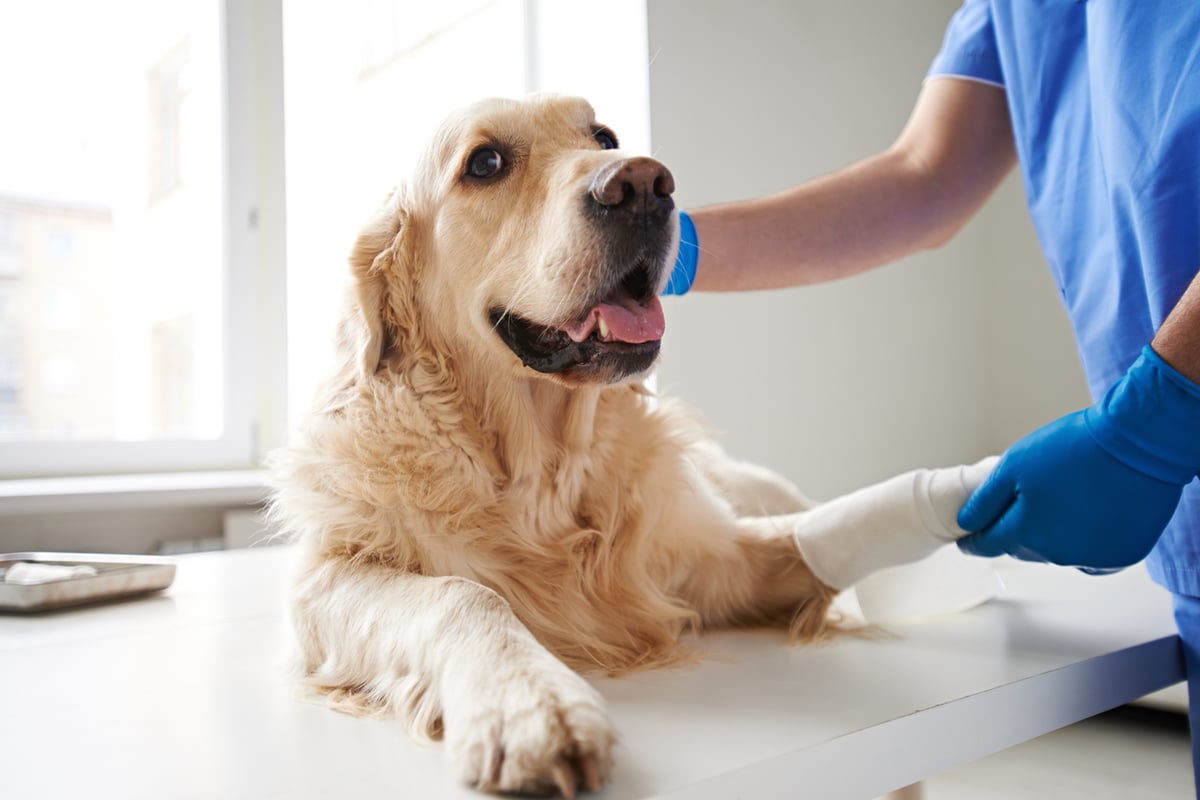
Taking steps to prevent a dog paw pad injury from happening in the first place is always a good idea. Here are some essential tips:
- Place carpet on slippery floors. Your dog’s paw pads can easily suffer friction burns from slippery floors due to it being more difficult to stop on them. Zoomies can easily end in disaster due to slippery floors, but putting down a few rugs can easily prevent that.
- Pick up debris in your yard. Whether you’ve just finished building a new fence or finally completed that DIY bookshelf, you’ll want to ensure that you clean up any wood chips, screws, nails, paint, and other hazards that could end up damaging your dog’s paws.
- Invest in pet stairs or a ramp. If your pup is older and has trouble getting up onto the bed or couch, consider investing in pet stairs or a ramp to help them out. Jumping and missing can cause broken toes and an injury to the dog paw pad. These structures usually have grippy surfaces to make it easy for your dog to climb them and help prevent slipping.
- Wash your dog’s feet thoroughly when coming back from a winter walk. Removing road salt and ice melt from your pup’s feet as soon as possible is important to prevent chemical burns. Be sure to check in between your dog’s toes and in their fur to make sure that you don’t miss any pieces that can cause an issue later on.
- Avoid walking your dog in excessive heat. Place the top of your hand on the sidewalk or asphalt. If it’s too hot for your hand, it’s too hot for your dog’s paws! Instead, walk your dog later when the sun isn’t as intense, or take them to a grassy area like a dog park to run and play instead.
Summary
Understanding the potential causes, symptoms, and treatments for dog paw pad injuries is essential for every dog owner. These injuries, although common, can vary widely in severity and require prompt attention and care. By being aware of the hazards your dog might face, such as sharp objects, hot pavement, or harsh chemicals, and taking preventive measures like booties and regular paw checks, you can significantly reduce the risk of a dog paw pad injury.
Remember, your veterinarian is your best resource for guidance on specific paw care products and tailored advice for your dog's unique needs. By prioritizing your dog's paw health and taking preventive actions, you can ensure that your furry friend enjoys a happy, active, and injury-free life.
Another important way that you can protect your dog’s digits is by giving them a daily joint supplement. A joint supplement will help strengthen your dog’s joint health, meaning that unexpected twists and turns while playing or running around will have less of a chance of causing injury. TRI-ACTA is a great preventative supplement for your dog, as it is a low-dose product with 100% natural ingredients. If your pup is already experiencing joint issues or is older, TRI-ACTA H.A. provides additional protection with the inclusion of hyaluronic acid.
TRI-ACTA for Pets
A proactive approach for developing and younger adult pets to maintain optimal joint health mobility, minimize inflammation and fend off age-related ailments.
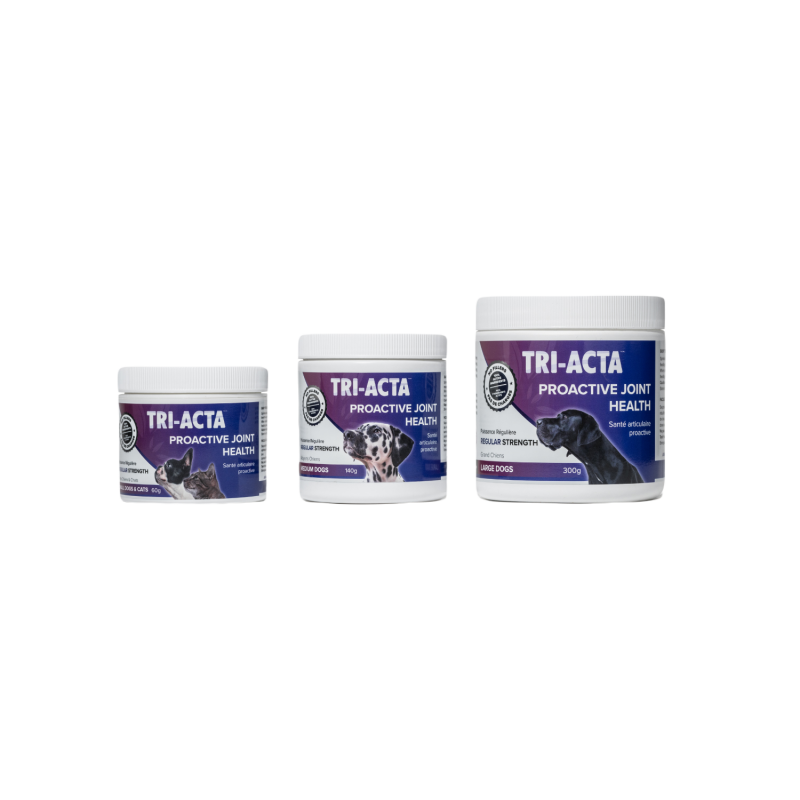
Buy TRI-ACTA online or discover where to buy in a store near you.
Newsletter Signup
Subscribe to our newsletter to receive the latest news and exclusive offers.
.jpg?height=2000&name=Cliick_Integricare-DISPLAY-REVISEDV2%20(1).jpg)
Proactive & Therapeutic Joint Supplements
When given daily, Integricare joint supplements recover bone and joint injuries faster and help prevent mobility injuries from happening in the first place.










